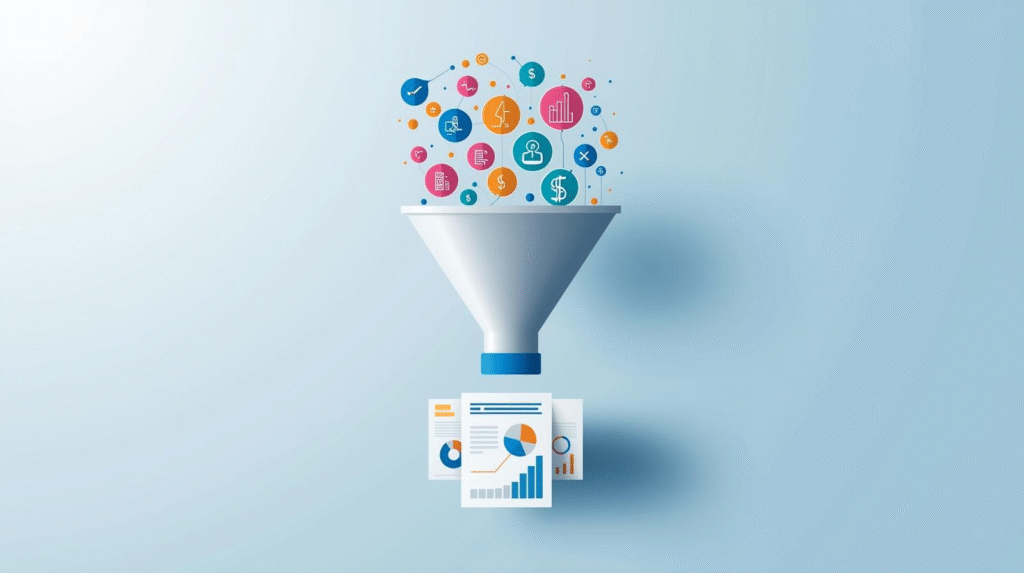In Ecommerce, data isn’t just helpful, it is your competitive advantage. Every successful Shopify store operates on something more than fantastic products or even smart marketing; it operates on transparent, trustworthy information. While design and branding may grab a few eyeballs on your Shopify storefront, but it is actually the statistical numbers that identify whether your brand is progressing.
Without those numerical figures, even a well decorated Shopify website can be at a standstill. You may notice decrease in revenue, an increase in refunds, or decrease in repeat purchases but never truly know the reasons. Thus, lack of proper knowledge about data leads to guesswork which is expensive.
The problem is not having less data, it is getting drowned in it. Your store creates thousands of data points a day across sales, returns, employee activity, and fulfilment. Understanding which of those measurements are important, and how to tie them together into a larger picture, is what distinguishes reactive store owners from strategic ones.
This is where the requirement for organized sales and order reports arise. Software such as ReportGuru makes disjointed data a coherent story about your customers, your earnings, and your potential for growth. So, we will be exploring the most effective reports you can have and how they can assist you in making decisions faster and wiser to grow your Shopify store with confidence.
Why Sales and Order Reports Are Important for Your Shopify Store?
Your Shopify store generates a massive amount of data from every click, purchase, refund, and return, everything leaves a digital footprint. Without a clear reporting system, this data can feel overwhelming. This is where the requirement of tools like ReportGuru arise, which provides structured, real-time reports that reveal trends, strengths, and weaknesses.

Here’s a sneak peek why these reports are essential:
- Identify top-selling products and unsold products.
- Understand customer purchasing behaviour.
- Monitor revenue by channel, vendor, or region.
- Catch issues early (such as increasing returns or decreasing staff performance).
- Make strategic business decisions.

Whether you are running a small Shopify store or a well-established Shopify website, these metrics provide the visibility you need to make informed business decisions.
Core Sales and Order Reports You Should Track
ReportGuru provides numerous options of valuable reports which are available under the category of Sales and Order reports. They are crafted to assist you in gaining insights from your Shopify store data. A brief description of the reports are as follows:
1. Checkout Currency Sales Report: The report indicates the amount of revenue your Shopify store is earning in various currencies. If you are selling worldwide, this is important in understanding how regions are performing and planning region-specific campaigns. Utilize this information in order to customize the language, pricing, and promotions of your for top-performing regions.
2. Daily Staff Sales at Register Report: This report segments daily staff sales. It is ideal for encouraging your staff and rewarding the top earners. Blending this with Staff-Attributed Retail Sales lets you differentiate among the best as well as hard-working contributors.
3. Employee Sales at Register Report: A more in-depth examination of sales trends specific to staff. This might identify training requirements or reveal leading sellers who can guide others.
4. Draft Order Completed Report: Draft orders frequently fly under the radar. This document monitors which draft orders are completed, allowing you to capture lost potential sales.
5. Finance Snapshot Report: A snapshot of your revenues, expenses, and profits at a glance. Consider it as a dashboard for your Shopify store, providing the insights to make smart planning of inventory and marketing spend.
6. Fulfilment Location Sales Report: If you are shipping out of several different locations, this report gives you insight into which fulfilment centres are generating the most revenue. Use it to streamline logistics to your Shopify online store.
7. Last 24 Hours Orders Report: Want to know what’s happening in real time? This report displays all orders within the last 24 hours, keeping you nimble in response to your customer demands.
8. Last 30 Days Sales Summary Report: This gives you a clear snapshot of your monthly performance, which is great for identifying trends, setting objectives, and mapping the next steps for your Shopify store.
9. Monthly Order vs Return Report: Excessive returns hurt profitability. This report compares returns to sales during the month so you can see product quality problems or misaligned customer expectations.
10. Order Summary Report: An overview of every order placed. This is the ultimate spot for everyone who wants to check the daily activities of their store.
11. Order Tags and Product Properties Report: Tags and properties can divide your data in meaningful ways such as, distinguishing wholesale from retail orders. This report keeps your Ecommerce store organized and simple for analysis.
12. POS Performance Summary Report: If you sell in your store with Shopify POS, this summary indicates how offline sales add up to your overall performance of your Shopify website.
13. Payment Terms Report: This report monitors payment terms and conditions, particularly a helpful one if your Shopify storefront has invoices or longer payment terms.
14. Outstanding Payments Report: Cash flow is important. This report indicates which orders are outstanding and requires payments, so you can follow up and maintain your store’s financial health.
15. Return & Refund Report: Almost every Shopify online store experience returns. This report allows you to identify trends such as, particular products being returned more frequently and optimize your listings accordingly.
16. Revenue by Collection Report: Collections categorize products into categories. This report tells you which collections generate the most revenue, so you can organize your Shopify website navigation and promotions better.
17. Revenue by Discount Code Report: This indicates how much revenue each discount code brought in, so you can see which promotions actually lead to sales on your Shopify store.
18. Sales over Time Report: Visualize your sales trends over weeks or months. This is crucial for forecasting and planning marketing campaigns for your Shopify storefront.
19. Sales Performance by Product Report: Find your star products and your underperformers. Focus on your marketing budget to keep a track of what’s working best in your Shopify store.
20. Sales by Region Report: Geographic insights assist you in tailoring ads and promotions. If your Shopify site experiences high sales from specific cities, you are able to localize campaigns for best effect.
21. Sales by Sales Channel Report: This indicates what channels (online store, POS, social media) are generating the most orders, so you have an idea of where to devote your efforts toward expanding your Ecommerce store.
22. Staff-Attributed Retail Sales Report: Drill down on which employees are generating maximum revenues. Identify top performers and establish incentive plans to enhance morale.
23. Variant Sales Report: Monitor what product variants, colours, sizes, or bundles are selling most on your Shopify store so you can plan timely inventory restocks.
24. Vendor Sales Report: This report indicates which suppliers are the most profitable. Use it to optimize supplier relationships and secure better discounts.
How to Turn Reports into Action?
Having access to reports is the initial step, but possessing proper knowledge of the accurate and profitable ways to use them is the most important step. Here are three steps to get the most from your Shopify storefront reports:
1. Review Reports Weekly: Establish a habit of looking at key metrics from your Shopify store on a weekly basis. Monitor sales trends, returns, and best-selling products.
2. Establish KPIs from Data: Utilize these reports to establish performance objectives for employees, products, and geography. Use the numbers to inform your Shopify store strategy.
3. Act Quickly on Insights: If an item has high returns, modify its description. If an area exhibits growth, localize your ads. Real-time action makes your store competitive.
Conclusion
Ecommerce success isn’t based on luck, it’s based on clarity. Each click, cart, and conversion within your Shopify site leaves behind information that can point towards your next best step. When you utilize that data effectively, you leave guesswork behind and start embracing growth.

Whether you are working with one Shopify store or operating a multi-location Shopify website, having insight into your sales performance, fulfilment patterns, and employee contributions can change the way you operate your business. Rather than responding to issues after the fact, you can stay ahead of challenges, invest in the effective resources, and create strategies based on evidence, instead of guesswork.

